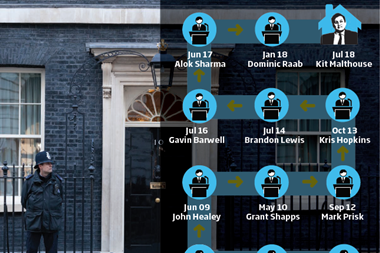The Ministry of Housing, Communities and Local Government has published its final version of the National Planning Policy Framework (NPPF)

The four focuses of the new document are:
• Promoting high quality design of new homes and places
• Stronger protection for the environment
• Building the right number of homes in the right places
• Greater responsibility and accountability for housing delivery from councils and developers
Eighty-five of the proposals set out in the housing white paper and the Budget have been implemented in the NPPF.
MHCLG said it would publish guidance for developers and councils to ensure that necessary infrastructure and affordable housing was provided, adding “…developers will know what is expected of them up front, even before they submit a planning application and councils have greater power to hold them to these commitments,”.
From November 2018, councils will have a new housing delivery test, which will be focused on increasing the numbers of homes actually delivered in their area, rather than the planned number.
Another of the priorities outlined centres on promoting high-quality design, and giving councils ‘the confidence and tools to refuse permission for development that does not prioritise design quality and does not complement its surroundings’.
Secretary of state for communities James Brokenshire said: “Fundamental to building the homes our country needs is ensuring that our planning system is fit for the future.
“This revised planning framework sets out our vision of a planning system that delivers the homes we need. I am clear that quantity must never compromise the quality of what is built, and this is reflected in the new rules”.
Property reactions:
- Ian Fletcher, director of real estate policy, British Property Federation: “Currently, methods employed to calculate housing need vary significantly across the country and result in significant time and cost burdens, fundamental flaws that will impede an ambitious housebuilding programme if not resolved. We strongly support the standardised approach to assessing housing need without exception. Equally, we support the housing delivery test – this will provide a consistent measure against which different local authorities’ performances can be compared. It is unfortunate that the NPPF doesn’t give more impetus to sustainable economic growth, and the policies required to allow businesses to invest, expand and adapt.”
- James Penfold, global planning director at The Collective: “Overall, we welcome these measures – and particularly support the focus on innovation in the design of new homes, alongside a technology-led approach to co-creation with local communities to help achieve this. Innovation and technology is key to streamlining the planning process, promoting housing delivery, and most importantly creating authentic places and lasting communities.”
- John McLarty, national head of planning, Strutt & Parker: “The policies contained in the new NPPF provide long overdue updates to government policy since it was first introduced in 2012. Critically it sets out a series of welcome proactive measures to improve the planning process and aid the delivery of housing.”
- Jason Lowes, partner, planning team, Rapleys: After all the cries to ‘free the NPPF’, with a couple of exceptions the new policy looks on the surface to be fairly similar to the draft released earlier in the year, not to mention the old one. There are some changes, however. For example the new NPPF implies greater reliance on larger sites. It puts far less pressure on local authorities to identify smaller sites to meet housing need. At the same time, there is more detail provided relative to new settlements.
- Mark Sitch, senior partner, Barton Willmore: Disappointingly there has been minimal change following consultation on the draft NPPF in March this year. The industry – from local authorities, interested parties to developers – provided substantial feedback and it was expected to see some of this translated into the final revised NPPF. There are however no big surprises and no real changes.The focus remains on housing. Overall, there is less, not more, for those looking to deliver employment floorspace.
- Paul Smith, managing director, The Strategic Land Group: Rather than making dramatic changes, the new NPPF policies are more about marginal gains, which the government hopes will make a big difference in aggregate. Looking at the full document, some of the initiatives are likely to be more successful than others - for instance, demonstrating the required need to allow entry-level exception sites to come forward seems likely to be challenging, and there is no recourse if councils aren’t proactive in helping with site assembly. However, the New Housing Delivery Test looks set to be a vitally important change - by looking back at the homes which have actually been delivered, it will complement the forward-looking five year supply calculations and put added pressure on councils to make sure that sites truly are deliverable.
- Richard Upton, deputy chief executive, U+I: “On balance the measures are positive, although do seem to increase the burden on our counterparts in local government at a time when they are already struggling to keep up with demand. Finding a better way to resource planning departments would be a very welcome addition to these proposals. But it’s important to recognise that the NPPF is simply a framework. It doesn’t dictate the spirit with which councils, developers and communities engage, which is the key to unlocking housing supply in this country. If developers engage in good faith with local councils, and importantly, with the communities they serve, then we can really set about delivering the homes and neighbourhoods our country is crying out for.”
- Dean Clifford, co-founder, Great Marlborough Estates: “The revised National Planning Policy Framework published today shows a greater focus on good design for housing. This is welcome news and represents an assurance that developers aim to deliver quality homes which will be supported by local authorities. What we deliver must be contextually sensitive, reflective of the fabric of the local community and mindful of architectural heritage. For too long planning policy has encouraged quantity - let us hope that the revised NPPF will see beauty brought back in housing design and delivery.”
- Larry Gold, deputy chief executive, Trafford Housing Trust: “Trafford Housing Trust is strongly supportive of a new housing delivery test for local authorities. This policy is vital to ensure there is greater focus in areas such as the North West, where there is significant demand for homes. At the same time, the government must work with local authorities to ensure targets are achievable.
- Mark Dodds, national head of planning and development, Lambert Smith Hampton: “Our take on the new framework is that it includes some interesting ideas and features that will help overall housing delivery. However, there are some measures that may impact the desired delivery of 300,000 new homes a year by the mid-2020s including shifting of the policy emphasis on viability testing to the local planning stage. Property insiders have been seeking more certainty regarding viability testing for some time but instant implementation may be a difficult pill to swallow. This is because it will have a short term impact on housing delivery, offset against greater certainty for developers in the future on the level of affordable housing that must be completed. This inevitably will effect developers sitting on large land-banks where high prices may have been paid for sites on the basis that affordable numbers could be reduced. With this window now shutting some sites may stand empty for some while yet.”






























No comments yet